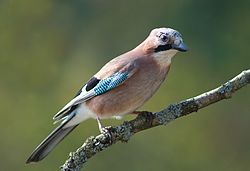Top Qs
Timeline
Chat
Perspective
Jay
Bird From Wikipedia, the free encyclopedia
Remove ads
Jays are a paraphyletic grouping of passerine birds within the family Corvidae. Although the term "jay" carries no taxonomic weight, most or all of the birds referred to as jays share a few similarities: they are small to medium-sized, usually have colorful feathers and are quite noisy. These superificial characteristics set them apart from most other corvids such as crows, ravens, jackdaws, rooks and magpies, which are larger and have darker plumage. Many so-called "jays" are genetically closer to these other corvids than other jays, however.
Remove ads
Systematics and species
Summarize
Perspective
Jays are not a monophyletic group. Anatomical and molecular evidence indicates they can be divided into a New World and an Old World lineage (the latter including the ground jays and the piapiac), while the grey jays of the genus Perisoreus form a group of their own.[1] The black magpies, formerly believed to be related to jays, are classified as treepies.
Old World ("brown") jays
Grey jays
New World jays
Remove ads
In culture
Slang
The word jay has an archaic meaning in American slang meaning a person who chatters impertinently.[2][3]
The term jaywalking was coined in the first decade of the 1900s to label persons crossing a busy street carelessly and becoming a traffic hazard.[4] The term began to imply recklessness or impertinent behavior as the convention became established.[5]
In January 2014, Canadian author Robert Joseph Greene embarked on a lobbying campaign among ornithologists in Europe and North America to get Merriam-Websters Dictionary to have a "Jabber of Jays" as an official term under bird groups.[6][7]
Remove ads
References
External links
Wikiwand - on
Seamless Wikipedia browsing. On steroids.
Remove ads










